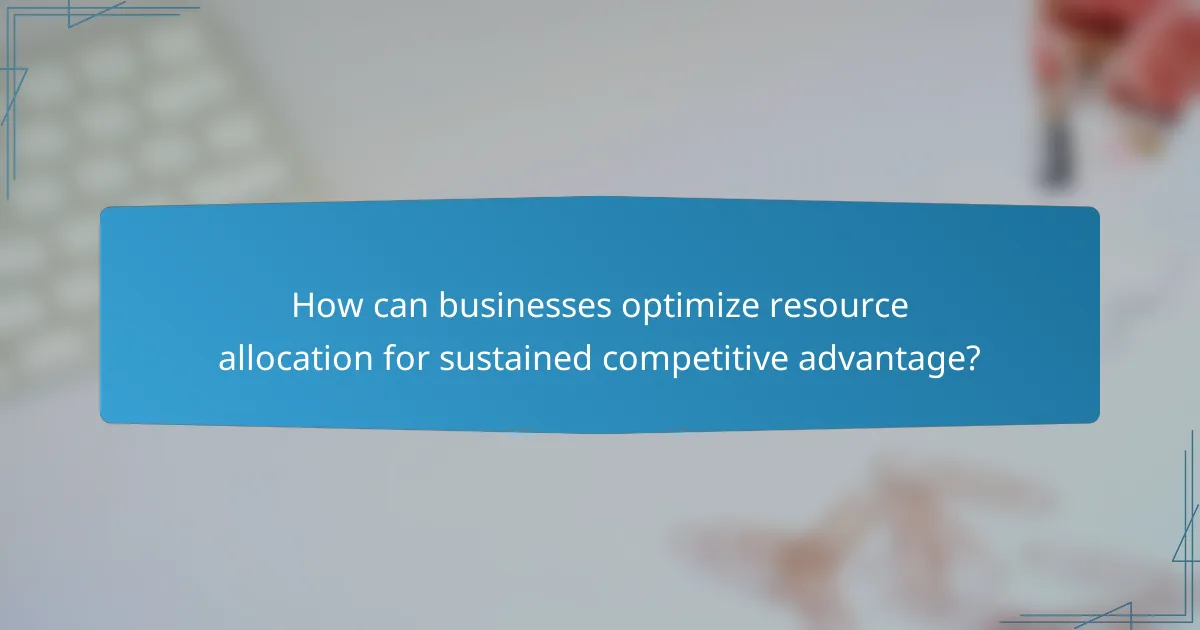The article explores the relationship between resource allocation and competitive advantage, emphasizing how effective resource distribution can enhance organizational capabilities. It outlines various resource allocation methods, including top-down, bottom-up, incremental, and zero-based allocation, each with distinct advantages and challenges. The discussion highlights the importance of strategic planning and data analysis in optimizing resource allocation to improve innovation, efficiency, and overall market performance. Research findings underscore that companies with superior resource allocation practices achieve higher returns and maintain competitiveness in dynamic environments. Regular reviews of resource allocation are also recommended to adapt to market changes and sustain a competitive edge.

What is the relationship between resource allocation and competitive advantage?
Resource allocation directly influences competitive advantage. Effective resource allocation allows organizations to optimize their capabilities. This optimization enables firms to respond quickly to market changes. Companies that allocate resources strategically can enhance their innovation and efficiency. This leads to improved product quality and customer satisfaction. Research shows that firms with superior resource allocation achieve higher market share. For example, a study by Barney (1991) emphasizes the link between resources and sustained competitive advantage. Therefore, strategic resource allocation is essential for maintaining competitiveness in dynamic environments.
How do resource allocation strategies influence competitive advantage?
Resource allocation strategies significantly influence competitive advantage by determining how effectively an organization utilizes its resources. Efficient allocation can enhance operational efficiency and reduce costs. This leads to improved profitability and market positioning. For instance, companies that invest in research and development often achieve innovation, giving them a competitive edge. According to a study by Barney (1991), firms with unique resource allocations can create barriers to entry for competitors. Thus, strategic resource allocation directly impacts a firm’s ability to outperform rivals.
What are the key components of resource allocation?
The key components of resource allocation are budgeting, prioritization, and distribution. Budgeting involves determining the financial resources available for various projects. It sets the limits for spending and investment. Prioritization assesses the importance of each project or resource need. It ensures that critical areas receive adequate attention and funding. Distribution refers to the actual deployment of resources across projects or departments. This process involves assigning resources based on the established budget and priorities. Effective resource allocation directly influences an organization’s competitive advantage by optimizing performance and efficiency.
How does effective resource allocation lead to a competitive edge?
Effective resource allocation leads to a competitive edge by optimizing the use of assets and capabilities. When organizations allocate resources efficiently, they can maximize productivity and minimize waste. This allows for faster innovation and responsiveness to market changes. Companies that effectively allocate resources can also focus on their core competencies. This strategic focus enhances their market position. For example, firms like Toyota have shown that efficient resource management leads to superior operational performance. Studies indicate that companies with effective resource allocation strategies outperform their competitors in profitability and market share.
Why is understanding this relationship important for businesses?
Understanding the relationship between resource allocation and competitive advantage is crucial for businesses. Effective resource allocation enhances operational efficiency and drives innovation. Businesses that allocate resources strategically can better respond to market changes. This agility often leads to improved customer satisfaction and loyalty. Research shows that firms with optimized resource allocation outperform competitors by 20% in profitability. Additionally, understanding this relationship allows businesses to identify and leverage unique strengths. This strategic insight fosters sustainable competitive advantages in dynamic markets. Ultimately, it positions businesses for long-term success and growth.
What role does resource allocation play in strategic planning?
Resource allocation is essential in strategic planning as it determines how resources are distributed to achieve organizational goals. Effective resource allocation ensures that critical areas receive the necessary support to drive strategic initiatives. It involves assessing available resources, including financial, human, and technological assets. Strategic planning relies on prioritizing resource allocation to maximize competitive advantage. For instance, a study by Kaplan and Norton (1996) emphasizes that aligning resources with strategic objectives enhances performance. Proper resource allocation mitigates risks and optimizes returns on investment. Ultimately, it facilitates informed decision-making and fosters sustainable growth.
How can businesses measure the impact of resource allocation on competitive advantage?
Businesses can measure the impact of resource allocation on competitive advantage through various quantitative and qualitative metrics. Key performance indicators (KPIs) such as return on investment (ROI) can help assess the financial effectiveness of resource distribution. Additionally, benchmarking against competitors can provide context regarding relative performance and market position.
Surveys and stakeholder feedback can offer qualitative insights into perceived advantages gained from resource allocation. Tools like balanced scorecards can integrate financial and non-financial metrics to provide a comprehensive view.
According to a study by Kaplan and Norton (1996), utilizing a balanced scorecard approach can enhance strategic alignment and performance measurement. This method allows businesses to track how effectively resources contribute to competitive positioning.

What are the different types of resource allocation methods?
There are several types of resource allocation methods. These methods include top-down allocation, bottom-up allocation, incremental allocation, and zero-based allocation.
Top-down allocation involves senior management deciding how resources are distributed across departments. This method can streamline decision-making but may overlook specific departmental needs.
Bottom-up allocation starts with individual departments proposing their resource needs. This approach can ensure that specific requirements are met but may lead to inefficiencies if not managed properly.
Incremental allocation adjusts previous budgets based on performance and future projections. This method is easy to implement but can perpetuate existing inefficiencies.
Zero-based allocation requires justifying every expense from scratch. This method promotes efficiency but can be time-consuming and labor-intensive.
Each method has its advantages and disadvantages, impacting organizational effectiveness and competitive advantage.
How do these methods vary across industries?
Resource allocation methods vary significantly across industries. In manufacturing, resource allocation focuses on optimizing production efficiency and minimizing waste. This often involves just-in-time inventory management and lean manufacturing principles. In contrast, the technology sector emphasizes agile resource allocation to foster innovation and rapid product development. Companies prioritize human capital and research and development investments to maintain a competitive edge.
In the service industry, resource allocation is often centered around customer experience and service quality. Businesses allocate resources to training staff and enhancing service delivery processes. The healthcare industry prioritizes resource allocation to improve patient outcomes and operational efficiency. This includes investments in technology and staff training to enhance care delivery.
Finally, the retail sector focuses on inventory management and supply chain efficiency. Retailers allocate resources to data analytics for better demand forecasting and inventory optimization. Each industry tailors its resource allocation strategies to meet specific operational goals and competitive challenges.
What are the strengths and weaknesses of each resource allocation method?
Resource allocation methods have distinct strengths and weaknesses. The first method, the top-down approach, offers strong strategic alignment. It ensures that resources are allocated according to organizational priorities. However, it can limit input from lower levels, potentially missing valuable insights.
The second method, the bottom-up approach, encourages participation from all levels. This can lead to innovative ideas and greater buy-in. However, it may result in misalignment with strategic goals and can be time-consuming.
The third method, the incremental approach, allows for flexibility and adjustments based on feedback. It can minimize risk by making small changes. Yet, it may lack a comprehensive view, leading to missed opportunities for larger strategic shifts.
Lastly, the zero-based budgeting method requires justification for all expenses. This can lead to more efficient resource use. However, it can be labor-intensive and may overlook long-term investments. Each method’s effectiveness varies based on organizational context and goals.
How can businesses choose the right method for their needs?
Businesses can choose the right method for their needs by assessing their specific goals and resources. They should evaluate the objectives they aim to achieve, such as increasing efficiency or reducing costs. Next, businesses must analyze the resources available, including budget, personnel, and technology. Understanding the target audience is also crucial, as it influences method selection. Additionally, businesses can compare different methods based on their effectiveness and alignment with strategic goals. Research indicates that aligning method choice with organizational strategy enhances competitive advantage. For instance, a study by Porter (1985) highlights the importance of fit between resources and competitive positioning.
What factors influence the effectiveness of resource allocation methods?
The effectiveness of resource allocation methods is influenced by several key factors. These factors include organizational goals, resource availability, and decision-making processes. Organizational goals set the direction for resource distribution. Clear goals enhance alignment and focus in allocation efforts. Resource availability determines the extent to which methods can be effectively implemented. Limited resources may constrain options and impact outcomes. Decision-making processes influence how resources are prioritized and allocated. Efficient processes can lead to optimal resource use. Additionally, external market conditions can affect allocation effectiveness. Market dynamics may require adjustments in resource distribution strategies. These factors collectively shape how effectively resources are allocated to achieve competitive advantage.
How do market conditions affect resource allocation decisions?
Market conditions significantly influence resource allocation decisions. Companies assess demand, competition, and economic trends. High demand may lead to increased investment in production capacity. Conversely, low demand can result in cost-cutting measures. Competitive pressures force firms to allocate resources efficiently. For example, during economic downturns, businesses may prioritize essential operations. Research shows that firms adapting to market conditions often achieve better financial performance. A study by the Harvard Business Review found that agile resource allocation leads to a competitive advantage. Thus, understanding market conditions is crucial for effective resource management.
What internal factors should businesses consider when allocating resources?
Businesses should consider several internal factors when allocating resources. These factors include organizational structure, employee skills, and financial health. The organizational structure affects how resources are distributed across departments. Employee skills determine the effectiveness of resource utilization. Financial health indicates the available budget for resource allocation. Additionally, company culture influences decision-making processes. A strong culture can enhance resource efficiency. Lastly, technology infrastructure impacts the capability to deploy resources effectively. Each of these factors plays a critical role in optimizing resource allocation for competitive advantage.

How can businesses optimize resource allocation for sustained competitive advantage?
Businesses can optimize resource allocation for sustained competitive advantage by implementing strategic planning and data analysis. Strategic planning involves identifying key areas where resources can yield the highest returns. Data analysis helps in assessing market trends and consumer behavior.
Allocating resources to innovation and technology can enhance operational efficiency. For instance, companies that invest in automation often reduce costs and improve productivity. Additionally, focusing on employee development can lead to a more skilled workforce.
Research shows that organizations with effective resource allocation practices outperform competitors. A study by the Harvard Business Review found that companies that align resources with strategic goals achieve 30% higher returns.
Regularly reviewing resource allocation ensures adaptability to changing market conditions. This proactive approach allows businesses to maintain a competitive edge.
What best practices should be followed for effective resource allocation?
Effective resource allocation requires strategic planning and prioritization. First, organizations should assess their goals and objectives. This helps in aligning resources with key priorities. Next, conducting a thorough analysis of current resource utilization is essential. Understanding where resources are allocated can identify inefficiencies.
Additionally, utilizing data-driven decision-making enhances allocation effectiveness. Analytics can provide insights into performance and resource needs. Regularly reviewing and adjusting resource allocation based on changing circumstances is also crucial. This ensures resources remain aligned with evolving strategies.
Furthermore, involving stakeholders in the allocation process fosters buy-in and accountability. Collaboration can lead to more informed decisions. Finally, establishing clear metrics for success aids in evaluating the effectiveness of resource allocation. These practices collectively support better management of resources, ultimately leading to competitive advantage.
How can technology aid in resource allocation processes?
Technology can significantly enhance resource allocation processes through data analytics and automation. Data analytics provides insights into resource utilization patterns. This allows organizations to identify inefficiencies and optimize allocation. Automation streamlines the distribution of resources, reducing manual errors. For instance, software tools can predict resource needs based on historical data. This predictive capability enables proactive adjustments to resource allocation. Additionally, cloud-based platforms facilitate real-time collaboration and visibility across departments. This ensures that resources are allocated according to current demands. Overall, technology transforms resource allocation into a more efficient and informed process.
What metrics should businesses track to evaluate resource allocation success?
Businesses should track return on investment (ROI) to evaluate resource allocation success. ROI measures the profitability of investments relative to their costs. A higher ROI indicates effective resource use. Another important metric is cost per acquisition (CPA). CPA assesses the cost-effectiveness of acquiring new customers. Businesses should also monitor employee productivity metrics. These metrics reflect how efficiently resources are utilized within teams. Additionally, tracking project completion rates helps determine resource allocation effectiveness. Timely project delivery indicates successful resource management. Lastly, customer satisfaction scores provide insights into how well resources meet customer needs. High satisfaction often correlates with effective resource allocation.
What common challenges do businesses face in resource allocation?
Businesses face several common challenges in resource allocation. One major challenge is limited resources, which forces businesses to prioritize certain projects over others. This limitation can lead to underfunding critical initiatives. Additionally, businesses often struggle with misalignment between resources and strategic goals. When resources do not support the overall strategy, efficiency decreases. Another challenge is the difficulty in forecasting resource needs accurately. Inaccurate predictions can result in either surplus or shortages of resources. Furthermore, competition for resources within the organization can create conflicts among departments. This competition can hinder collaboration and lead to inefficiencies. Lastly, external factors, such as market changes, can disrupt resource allocation plans. These challenges collectively impact a business’s ability to achieve competitive advantage.
How can businesses overcome these challenges?
Businesses can overcome challenges by optimizing resource allocation. Effective resource allocation improves operational efficiency. It allows businesses to focus on high-impact areas. Prioritizing projects based on strategic goals enhances competitive advantage. Implementing data-driven decision-making supports better allocation choices. Regularly reviewing resource distribution ensures alignment with market demands. Training employees on resource management fosters a culture of efficiency. Research shows that companies with agile resource allocation are 30% more likely to outperform competitors.
What are the potential consequences of poor resource allocation?
Poor resource allocation can lead to significant negative outcomes for organizations. It often results in wasted financial resources, which can diminish profitability. Inefficient use of human resources may lead to employee burnout and decreased morale. Poorly allocated time can result in missed deadlines and lost opportunities. Additionally, misallocation can hinder innovation by restricting funding for new projects. This can ultimately weaken competitive advantage in the market. Studies indicate that companies with effective resource allocation strategies outperform their competitors. For example, research by the Harvard Business Review shows that effective resource management can increase productivity by up to 30%.
What practical strategies can businesses implement to enhance resource allocation?
Businesses can enhance resource allocation by implementing data-driven decision-making processes. This involves utilizing analytics to assess resource utilization and identify inefficiencies. Regularly reviewing resource allocation allows businesses to adjust based on performance metrics. Prioritizing projects that align with strategic goals ensures resources are focused on high-impact areas.
Additionally, adopting agile methodologies can improve flexibility in resource allocation. This approach allows for rapid reallocation of resources in response to changing market conditions. Investing in training and development enhances employee skills, leading to more effective use of resources.
Establishing clear communication channels ensures that all team members are aligned on resource needs and availability. Lastly, leveraging technology, such as project management tools, can streamline resource tracking and allocation. Studies show that organizations with effective resource management practices can achieve up to 30% higher productivity.
The main entity of the article is the relationship between resource allocation and competitive advantage. This article provides a strategic overview of how effective resource allocation influences an organization’s ability to optimize capabilities, enhance innovation, and improve operational efficiency. Key components such as budgeting, prioritization, and distribution are discussed, along with various allocation methods and their implications across different industries. The article emphasizes the importance of aligning resource allocation with strategic goals to achieve sustained competitive advantage and outlines practical strategies for overcoming common challenges in resource management.